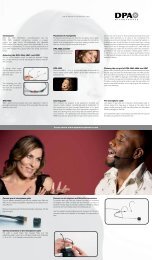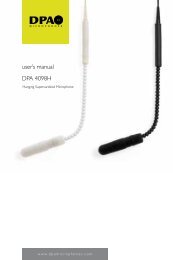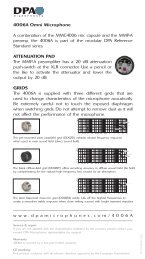The essentials of microphone technology â how ... - DPA Microphones
The essentials of microphone technology â how ... - DPA Microphones
The essentials of microphone technology â how ... - DPA Microphones
Create successful ePaper yourself
Turn your PDF publications into a flip-book with our unique Google optimized e-Paper software.
When reproducing very high frequencies, large diaphragm<br />
<strong>microphone</strong>s have a more limited range than<br />
the small diaphragms. This is caused by three factors:<br />
1. A large diaphragm tends to break up and will no<br />
longer act as a true piston. This phenomenon is also<br />
recognized in loudspeaker <strong>technology</strong> and is the reason<br />
why loudspeakers are manufactured with different sizes<br />
<strong>of</strong> diaphragms to handle different frequencies.<br />
2. <strong>The</strong> weight <strong>of</strong> the diaphragm will attenuate the displacement<br />
<strong>of</strong> the diaphragm for higher frequencies.<br />
3. <strong>The</strong> diffractions around the edges <strong>of</strong> the <strong>microphone</strong><br />
capsule will limit the <strong>microphone</strong>’s capability to handle<br />
very high frequencies.<br />
Conclusion<br />
Both diaphragm sizes have their respective advantages<br />
and disadvantages. This is illustrated in this table, which<br />
compares the specifications <strong>of</strong> <strong>DPA</strong>’s small and large diaphragm<br />
<strong>microphone</strong>s:<br />
How to read<br />
mic specifications<br />
When you read <strong>microphone</strong> specifications in order to<br />
compare different <strong>microphone</strong>s, it is extremely important<br />
that you understand <strong>how</strong> to interpret them.<br />
In most cases the specifications can be measured or calculated<br />
in many different ways. This article is designed to<br />
help evaluate specifications in a meaningful way.<br />
While <strong>microphone</strong> specifications provide an indication<br />
<strong>of</strong> a <strong>microphone</strong>’s electro-acoustic performance, they will<br />
not give you the total appreciation <strong>of</strong> <strong>how</strong> it will sound<br />
– just as it is with cars. Knowing that it is a 3.0 turboengine<br />
with 4WD gives you an idea <strong>of</strong> a pretty good<br />
driving experience, but for the exact feeling, you need to<br />
drive the car yourself.<br />
Frequency range/frequency response<br />
Frequency range tells you the range <strong>of</strong> the frequencies<br />
(for example 20 Hz to 20 kHz) that the <strong>microphone</strong><br />
can pick up and reproduce, but not <strong>how</strong> well the different<br />
frequencies are reproduced. To see that you need<br />
the frequency response:<br />
10<br />
dB<br />
5<br />
0<br />
On-axis<br />
-5<br />
-10<br />
5 dB Diffuse<br />
-15<br />
10 20 Hz 50 100 200 Hz 500 1 kHz 2 5 10 20 40<br />
Both diaphragm sizes have their respective advantages<br />
and disadvantages. This is illustrated in the table above.<br />
Frequency response <strong>of</strong> <strong>DPA</strong> 4006 Omnidirectional Microphone,<br />
P48.<br />
Here you see <strong>how</strong> linear the response is or if the <strong>microphone</strong><br />
has any ‘spikes’. But pay attention to the scale<br />
on the left. <strong>The</strong> number <strong>of</strong> dB each step represents can<br />
vary a lot.<br />
<strong>The</strong> frequency response normally refers to the on-axis response,<br />
which means from a sound source right in front<br />
<strong>of</strong> the <strong>microphone</strong>. <strong>The</strong> diffuse field response curve will<br />
illustrate <strong>how</strong> the <strong>microphone</strong> will respond in a highly<br />
reverberant sound field.<br />
It is also important to examine the <strong>of</strong>f-axis response.<br />
A <strong>microphone</strong> always takes in sound from the sides too,<br />
the question is just <strong>how</strong> much and <strong>how</strong> good it sounds.<br />
In particular, directional <strong>microphone</strong>s can, in their attempt<br />
to suppress sound from the sides, get an uneven<br />
<strong>of</strong>f-axis response:<br />
<strong>The</strong> <strong>essentials</strong> <strong>of</strong> <strong>microphone</strong> <strong>technology</strong>: How to choose the right mic for the job

















